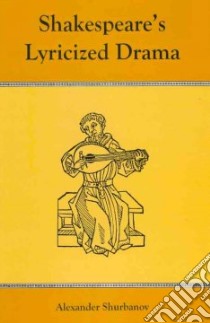Shakespeare's Lyricized Drama - 9780874130867
Un libro in lingua di Alexander Shurbanov edito da Associated Univ Pr, 2010
- € 53.90
- Il prezzo è variabile in funzione del cambio della valuta d’origine
This book explores Shakespeare's poetic drama as a blend of the dramatic and the lyrical. Through a series of minute textual analyses, it traces the gradual integration of the two modes from Love's Labour's Lost to Hamlet and the other mature tragedies. How this combination is effected in its details is a question that can help us understand better the specificity of Shakespeare's innovative work for the theater and the power of its impact.
To start with, the Introduction provides a critical survey of the theoretical discourse around the notions of dramatic and lyric as the two basic terms of all further discussion in the study. It draws attention to the Renaissance's keen interest in genre and its potential for combination and change.
The analytical section of the book, devoted to a concrete study of Shakespeare's plays, is divided into two parts: "Generic Mixture: Lyrical Incursion into Drama" and "Generic Integration: Lyrical Presence in Drama."
The first of these focuses on three plays of different genres written in the mid-1590s. Love's Labour's Lost is viewed as an example of the consistent insertion of lyrical elements into the dramatic text, above all in the form of poetic insets: poems and songs, as well as a number of the monologues, especially those of Berowne. The penetration of the lyric into this play is also discovered in the characteristic molding of tracts of dialogue. The interplay of the two modes and their mutual influences are observed at every level of the dramatic composition. In Romeo and Juliet we witness a further development of the same methods, but also a tendency of gradual relaxation of the isolated lyrical forms and their merging into the dramatic text with the effect of the latter's fuller generic modulation. The "architectonic" levels of plot and character too are now clearly dependent on lyrical structuring. This is even more so in Richard II, the pivot of whose construction is the contrast between two central dramatic figures: the contemplative man, the "poet" King Richard, and the man of action, the "hero" Henry Bolingbroke.
What follows in the second part of the analytical section is a consideration of two dramas, a comedy and a tragedy, produced at the turn of the century and ushering in the period of Shakespeare's artistic maturity, As You Like It and Hamlet. In its own way, each of them is suffused with an overwhelmingly dominant individuality, which approaches the status of the lyrical persona, monopolizing and thus in effect lyricizing the drama.
The Conclusion sums up the most important tendencies of the process of generic integration in Shakespeare's dramaturgy and then glances at their consummation in the subsequent period of the Great Tragedies.
Informazioni bibliografiche
- Titolo del Libro in lingua: Shakespeare's Lyricized Drama
- Lingua: English
- Autore: Alexander Shurbanov
- Editore: Associated Univ Pr
- Collana: Associated Univ Pr (Hardcover)
- Data di Pubblicazione: 31 Gennaio '10
- Genere: LITERARY CRITICISM
- Argomenti : Drama Technique
- Pagine: 311
- ISBN-10: 0874130867
- EAN-13: 9780874130867


